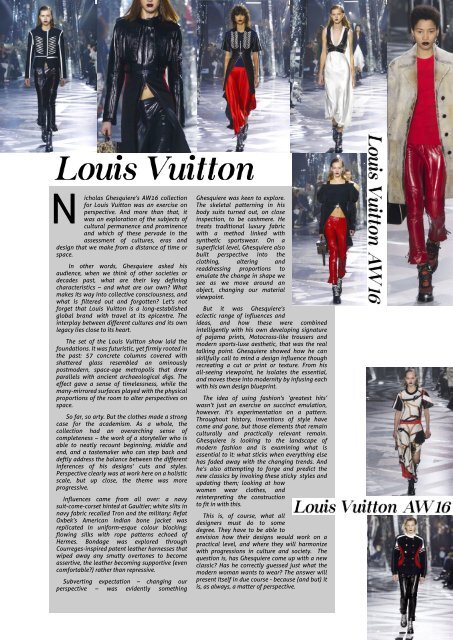Portfolio - Jem Leslie-24
You also want an ePaper? Increase the reach of your titles
YUMPU automatically turns print PDFs into web optimized ePapers that Google loves.
Paris show review<br />
Nicholas Ghesquiere?s AW16 collection<br />
for Louis Vuitton was an exercise on<br />
perspective. And more than that, it<br />
was an exploration of the subjects of<br />
cultural permanence and prominence<br />
and which of these pervade in the<br />
assessment of cultures, eras and<br />
design that we make from a distance of time or<br />
space.<br />
In other words, Ghesquiere asked his<br />
audience, when we think of other societies or<br />
decades past, what are their key defining<br />
characteristics ? and what are our own? What<br />
makes its way into collective consciousness, and<br />
what is filtered out and forgotten? Let's not<br />
forget that Louis Vuitton is a long-established<br />
global brand with travel at its epicentre. The<br />
interplay between different cultures and its own<br />
legacy lies close to its heart.<br />
The set of the Louis Vuitton show laid the<br />
foundations. It was futuristic, yet firmly rooted in<br />
the past: 57 concrete columns covered with<br />
shattered glass resembled an ominously<br />
postmodern, space-age metropolis that drew<br />
parallels with ancient archaeological digs. The<br />
effect gave a sense of timelessness, while the<br />
many-mirrored surfaces played with the physical<br />
proportions of the room to alter perspectives on<br />
space.<br />
So far, so arty. But the clothes made a strong<br />
case for the academism. As a whole, the<br />
collection had an overarching sense of<br />
completeness ? the work of a storyteller who is<br />
able to neatly recount beginning, middle and<br />
end, and a tastemaker who can step back and<br />
deftly address the balance between the different<br />
inferences of his designs? cuts and styles.<br />
Perspective clearly was at work here on a holistic<br />
scale, but up close, the theme was more<br />
progressive.<br />
Influences came from all over: a navy<br />
suit-come-corset hinted at Gaultier; white slits in<br />
navy fabric recalled Tron and the military; Refat<br />
Oxbek?s American Indian bone jacket was<br />
replicated in uniform-esque colour blocking;<br />
flowing silks with rope patterns echoed of<br />
Hermes. Bondage was explored through<br />
Courreges-inspired patent leather harnesses that<br />
wiped away any smutty overtones to become<br />
assertive, the leather becoming supportive (even<br />
comfortable?) rather than repressive.<br />
Subverting expectation ? changing our<br />
perspective ? was evidently something<br />
Ghesquiere was keen to explore.<br />
The skeletal patterning in his<br />
body suits turned out, on close<br />
inspection, to be cashmere. He<br />
treats traditional luxury fabric<br />
with a method linked with<br />
synthetic sportswear. On a<br />
superficial level, Ghesquiere also<br />
built perspective into the<br />
clothing, altering and<br />
readdressing proportions to<br />
emulate the change in shape we<br />
see as we move around an<br />
object, changing our material<br />
viewpoint.<br />
But it was Ghesquiere?s<br />
eclectic range of influences and<br />
ideas, and how these were combined<br />
intelligently with his own developing signature<br />
of pajama prints, Motocross-like trousers and<br />
modern sports-luxe aesthetic, that was the real<br />
talking point. Ghesquiere showed how he can<br />
skillfully call to mind a design influence though<br />
recreating a cut or print or texture. From his<br />
all-seeing viewpoint, he isolates the essential,<br />
and moves these into modernity by infusing each<br />
with his own design blueprint.<br />
The idea of using fashion's ?greatest hits?<br />
wasn?t just an exercise on succinct emulation,<br />
however. It?s experimentation on a pattern.<br />
Throughout history, inventions of style have<br />
come and gone, but those elements that remain<br />
culturally and practically relevant remain.<br />
Ghesquiere is looking to the landscape of<br />
modern fashion and is examining what is<br />
essential to it: what sticks when everything else<br />
has faded away with the changing trends. And<br />
he?s also attempting to forge and predict the<br />
new classics by invoking these sticky styles and<br />
updating them; looking at how<br />
women wear clothes, and<br />
reinterpreting the construction<br />
to fit in with this.<br />
This is, of course, what all<br />
designers must do to some<br />
degree. They have to be able to<br />
envision how their designs would work on a<br />
practical level, and where they will harmonize<br />
with progressions in culture and society. The<br />
question is, has Ghesquiere come up with a new<br />
classic? Has he correctly guessed just what the<br />
modern woman wants to wear? The answer will<br />
present itself in due course - because (and but) it<br />
is, as always, a matter of perspective.



